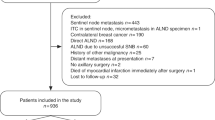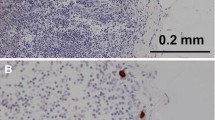Abstract
Purpose
To evaluate the prognostic significance of isolated tumor cells found on sentinel node biopsy.
Methods
The study is based on a prospectively followed up cohort of 1,865 consecutive patients diagnosed with pT1 (tumor size ≤20 mm) breast cancer in one university breast unit between February 2001 and August 2005. Of the 1,390 patients who received no neoadjuvant therapy and who underwent sentinel node biopsy, 63 had isolated tumor cells in the sentinel nodes (stage pT1N0i + M0, verified by axillary node dissection) and 868 did not (pT1N0i − M0). Median follow-up time was 55 months.
Results
Patients with pN0i+ disease received systemic adjuvant therapies more often than those with pN0i− disease (87 versus 51%; P < 0.0001). There was no significant difference between the groups in terms of 5-year recurrence-free survival (90.3 versus 93.2%, respectively; P = 0.32) or overall survival, but patients with pN0i+ cancer had less favorable 5-year breast-cancer-specific survival (95.2 versus 98.4%; P = 0.035) than those with pN0i− cancer, and they were more frequently diagnosed with distant metastases from breast cancer during the first 5 years of follow-up (8.1 versus 1.9%, respectively; P = 0.001). Some conventional prognostic factors, such as histological grade, steroid hormone receptor status, and cell proliferation rate, were more strongly associated with outcome than was pN0i status.
Conclusions
The findings suggest that presence of isolated tumor cells in the sentinel nodes is an adverse prognostic factor in early breast cancer, but its prognostic significance in association with standard factors may be limited.


Similar content being viewed by others
References
Veronesi U, Cascinelli N, Greco M, et al. Prognosis of breast cancer patients after mastectomy and dissection of internal mammary nodes. Ann Surg. 1985;202:702–7.
Cote RJ, Peterson HF, Chaiwun B, et al. Role of immunohistochemical detection of lymph-node metastases in management of breast cancer. International Breast Cancer Study Group. Lancet. 1999;354:896–900.
Dowlatshahi K, Fan M, Anderson JM, Bloom KJ. Occult metastases in sentinel nodes of 200 patients with operable breast cancer. Ann Surg Oncol. 2001;8:675–81.
Gray RJ, Cox CE, Reintgen DS. Importance of missed axillary micrometastases in breast cancer patients. Breast J. 2001;7:303–7.
International (Ludwig) Breast Cancer Study Group. Occult axillary lymph-node micrometastases in breast cancer. Lancet. 1990; 336:434–5.
Wilkinson EJ, Hause LL, Hoffman RG, et al. Occult axillary lymph node metastases in invasive breast carcinoma: characteristics of the primary tumor and significance of the metastases. Pathol Annu. 1982;17 Pt 2:67–91.
Cody HS,3rd, Borgen PI, Tan LK. Redefining prognosis in node-negative breast cancer: can sentinellymph node biopsy raise the threshold for systemic adjuvant therapy? Ann Surg Oncol. 2004;11:227S–30S.
Sobin H, Wittekind C. UICC TNM classification of malignant tumours, 6th ed. New York: Wiley; 2002.
Colleoni M, Rotmensz N, Peruzzotti G, et al. Size of breast cancer metastases in axillary lymph nodes: clinical relevance of minimal lymph node involvement. J Clin Oncol. 2005;23:1379–89.
Kuijt GP, Voogd AC, van de Poll-Franse LV, Scheimans LJEE, van Beek MWPM, Roumen RMH. The prognostic significance of axillary lymph-node micrometastases in breast cancer patients. Eur J Surg Oncol. 2005;31:500–5.
Chen SL, Hoehne FM, Giuliano AE. The prognostic significance of micrometastases in breast cancer: A SEER population-based analysis. Ann Surg Oncol. 2007;14:3378–84.
Cox CE, Kiluk JV, Riker AI, et al. Significance of sentinel lymph node micrometastases in human breast cancer. J Am Coll Surg. 2008;206:261–8.
Cobardhan PD, Elias SG, Madsen EVE, Bongers V, Ruitenberg HJM, Perre CI, et al. Prognostic value of micrometastases in sentinel lymph nodes of patients with breast carcinoma: a cohort study. Ann Oncol. 2009;20:41–8.
Querzoli P, Pedriali M, Rinaldi R, et al. Axillary lymph node nanometastases are prognostic factors for disease-free survival and metastatic relapse in breast cancer patients. Clin Cancer Res. 2006;12:6696–701.
Tan LK, Giri D, Hummer AJ, et al. Occult axillary node metastases in breast cancer are prognostically significant: results in 368 node-negative patients with 20-year follow-up. J Clin Oncol. 2008;26:1803–9.
Pugliese MS, Beatty JD, Tickman RJ, et al. Impact and outcomes of routine microstaging of sentinel lymph nodes in breast cancer: significance of the pN0(i +) and pN1mi categories. Ann Surg Oncol. 2009;16:113–20.
Hansen NM, Ye X, Grube BJ, Giuliano AE. Manipulation of the primary breast tumor and the incidence of sentinel node metastases from invasive breast cancer. Arch Surg. 2004;139:634–9.
Newman EL, Kahn A, Diehl KM, et al. Does the method of biopsy affect the incidence of sentinel lymph node metastases? Breast J. 2006;12:53–7.
Diaz NM, Cox CE, Ebert M, et al. Benign mechanical transport of breast epithelial cells to sentinel lymph nodes. Am J Surg Pathol. 2004;28:1641–5.
Bleiweiss IJ, Nagi CS, Jaffer S. Axillary sentinel lymph nodes can be falsely positive due to iatrogenic displacement and transport of benign epithelial cells in patients with breast carcinoma. J Clin Oncol. 2006;24:2013–8.
Leikola JP, Toivonen TS, Krogerus LA, von Smitten KAJ. Rapid Immunohistochemistry enhances the intraoperative diagnosis of sentinel lymph node metastases in invasive lobular breast carcinoma. Cancer. 2005;104:14–9.
Tavassoli FA, Devilee P, editors. Pathology and genetics of tumours of the breast and female genital organs. In: World Health Organization classification of tumours. Lyon: IARC; 2003.
Joensuu H, Kellokumpu-Lehtinen P, Bono P, et al. Adjuvant docetaxel or vinorelbine with or without trastuzumab for breast cancer. N Engl J Med. 2006;354:809–20.
Teppo L, Pukkala E, Saxén E. Multiple cancer—an epidemiologic exercise in Finland. J Natl Cancer Inst. 1985;75:207–17.
Joensuu H, Lehtimäki T, Holli K, et al. Risk for distant recurrence of breast cancer detected by mammography screening or other means. JAMA 2004;292:1064–73.
Langer I, Guller U, Hsu-Schmitz SF, et al. Sentinel lymph node biopsy is associated with improved survival compared to level I&II axillary lymph node dissection in node negative breast cancer patients. Eur J Surg Oncol 2009;805–13.
van Deurzen CHM, de Boer M, Monninkhof EM, Bult P, van der Wall E, Tjan-Heinen VCG, et al. Non-sentinel lymph node metastases associated with isolated breast cancer cells in the sentinel node. J Natl Cancer Inst 2008;100:1574–80.
Houvenaeghel G, Nos C, Mignotte H, et al. Micrometastases in sentinel lymph node in a multicentric study: predictive factors of nonsentinel lymph node involvement—Groupe Des Chirurgiens De La Federatation Des Centres De Lutte Contre De Cancer. J Clin Oncol. 2006;24:1814–22.
Viale G, Maiorano E, Mazzarol G, et al. Histologic detection and clinical implications of micrometastases in axillary sentinel lymph nodes for patients with breast carcinoma. Cancer. 2001;92:1378–84.
de Mascarel I, MacGrogan G, Debled M, Brouste V, Mauriac L. Distinction between isolated tumor cells and micrometastases in breast cancer. Is it reliable and useful? Cancer. 2008;112:1672–8.
Joensuu H, Toikkanen S. Cured of breast cancer. J Clin Oncol. 1995;13:62–9.
De Boer M, van Deurzen CH, van Dijck JA, et al. Micrometastases and isolated tumor cells: relevant and robust or rubbish? (MIRROR): preliminary results of the MIRROR study from the Dutch breast cancer trialists, group (BOOG). Cancer Res. 2009;69:70s.
De Boer M, van Deurzen CH, van Dijck JA, et al. Micrometastases or isolated tumor cells and the outcome of breast cancer. N Engl J Med. 2009;361:653–63.
Acknowledgment
The study was supported by grants from the Helsinki University Hospital Research Fund, Cancer Society of Finland, Sigrid Juselius Foundation, and Academy of Finland.
Disclosures
The authors have no potential conflicts of interest.
Author information
Authors and Affiliations
Corresponding author
Rights and permissions
About this article
Cite this article
Leidenius, M.H.K., Vironen, J.H., Heikkilä, P.S. et al. Influence of Isolated Tumor Cells in Sentinel Nodes on Outcome in Small, Node-Negative (pT1N0M0) Breast Cancer. Ann Surg Oncol 17, 254–262 (2010). https://doi.org/10.1245/s10434-009-0723-y
Received:
Published:
Issue Date:
DOI: https://doi.org/10.1245/s10434-009-0723-y




